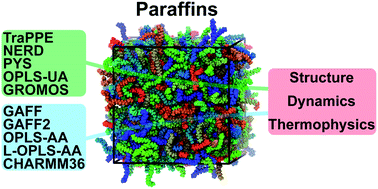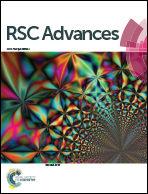Toward realistic computer modeling of paraffin-based composite materials: critical assessment of atomic-scale models of paraffins†
Abstract
Paraffin-based composites represent a promising class of materials with numerous practical applications such as e.g. heat storage. Computer modeling of these complex multicomponent systems requires a proper theoretical description of both the n-alkane matrix and the non-alkane filler molecules. The latter can be modeled with the use of a state-of-the-art general-purpose force field such as GAFF, CHARMM, OPLS-AA and GROMOS, while the paraffin matrix is traditionally described in the frame of relatively old, alkane-specific force fields (TraPPE, NERD, and PYS). In this paper we link these two types of models and evaluate the performance of several general-purpose force fields in computer modeling of paraffin by their systematic comparison with earlier alkane-specific models as well as with experimental data. To this end, we have performed molecular dynamics simulations of n-eicosane bulk samples with the use of 10 different force fields: TraPPE, NERD, PYS, OPLS-UA, GROMOS, GAFF, GAFF2, OPLS-AA, L-OPLS-AA, and CHARMM36. For each force field we calculated several thermal, structural and dynamic characteristics of n-eicosane over a wide temperature range. Overall, our findings show that the general-purpose force fields such as CHARMM36, L-OPLS-AA and GAFF/GAFF2 are able to provide a realistic description of n-eicosane samples. While alkane-specific models outperform most general-purpose force fields as far as the temperature dependence of mass density, the coefficient of volumetric thermal expansion in the liquid state, and the crystallization temperature are concerned, L-OPLS-AA, CHARMM36 and GAFF2 force fields provide a better match with experiment for the shear viscosity and the diffusion coefficient in melt. Furthermore, we show that most general-purpose force fields are able to reproduce qualitatively the experimental triclinic crystal structure of n-eicosane at low temperatures.



 Please wait while we load your content...
Please wait while we load your content...